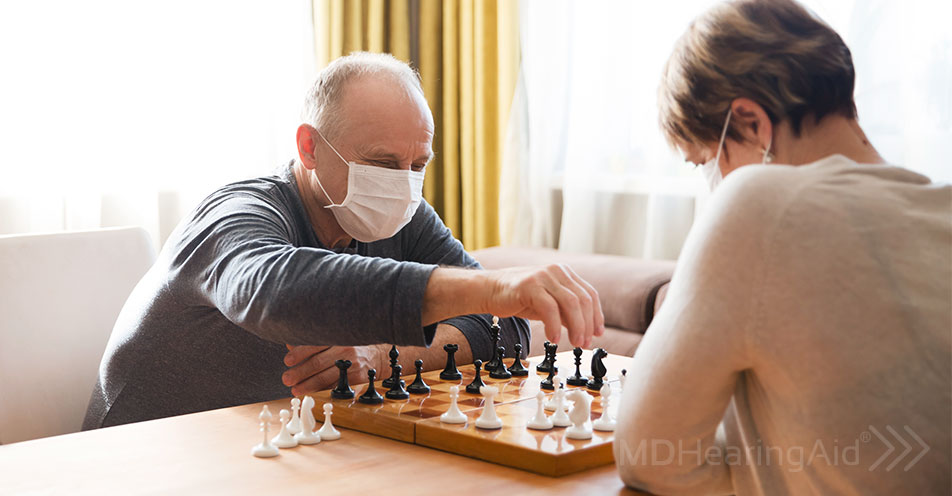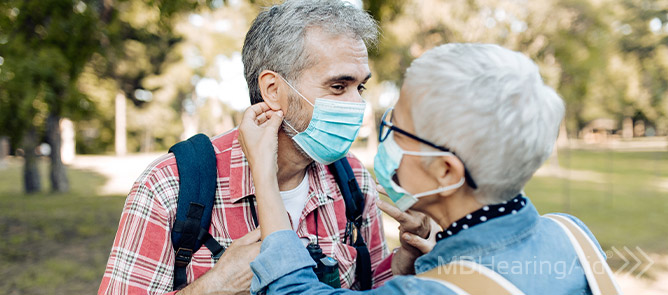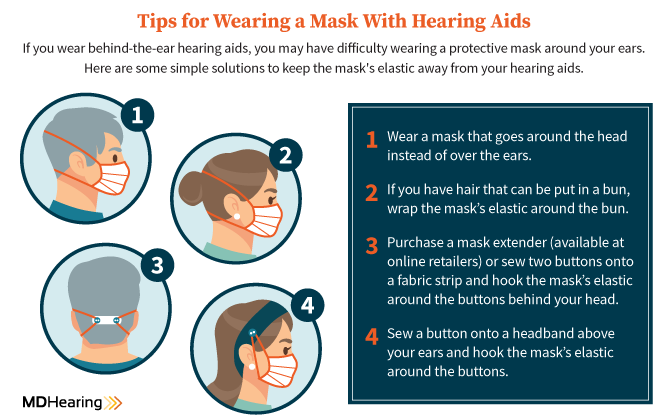Face masks reduce the chances of spreading coronavirus, but they present a serious challenge for people suffering from hearing loss. For example, if you or someone you love is hard of hearing, you may have encountered the following difficulties:
- Hidden lips and voice muffling: Masks hide lips and facial expressions, which creates an impossible obstacle for the deaf and hard of hearing. Masks also muffle voices, making it hard to understand what others are saying.
- BTE hearing aids and tangled mask straps: The straps of masks can get tangled with behind-the-ear (BTE) and receiver-in-canal (RIC) hearing aids. This can pull the hearing aids out of your ears when you take off the mask, causing loss or damage to the hearing aids.
Since many people are experiencing these difficulties during COVID-19, we wrote this article to offer some practical solutions – so you can stay safe from the virus, understand what people are saying, and wear your face mask and hearing aids with ease.
Hidden Lips and Voice Muffling from Face Masks
Most people with hearing loss rely on lipreading and face-reading for context and understanding during conversations. However, muffling and distorting sounds with a face mask – and standing further apart – makes speech comprehension difficult for those with hearing loss during COVID-19. The N95 masks and FFP3 respirators that frontline healthcare workers use are even worse because they intensify the dampening and distortion of sounds. This can make a trip to the hospital – or just communicating with family members – particularly distressing during the pandemic.
The deaf and hard of hearing who communicate with American Sign Language (ASL) face greater challenges. ASL grammar relies on facial expressions and mouth movements for clear expression, so wearing a mask seriously interferes with ASL communication.
Ultimately, it doesn’t matter whether you’re deaf, hard of hearing, or simply have a mild case of age-related hearing loss. Listening to a mask-wearer during COVID-19 is like talking to someone who is hiding behind a screen. You need to hear like a coyote to understand what they’re saying!
Fortunately, all is not lost. We have a few tips to make sure nothing gets “lost in translation” for the remainder of the pandemic.
Solutions for Mask-Related Hearing Challenges
Solving mask-related hearing challenges is easier said than done. A lot of people point to the idea of donning facemasks with translucent fronts that enable lipreading. This could work among family members and friends because they will be eager to help you by wearing clear masks – but convincing everyone in the world to follow the clear-mask trend is far from realistic.
More poignantly, the clear-mask solution isn’t perfect because these masks still muffle sounds and obscure important parts of the face from view. In addition, these masks have the most high-frequency roll-off which impairs communication, so in essence you are trading one problem for another. As deaf writer Sara Nović points out in the Washington Post:
While these [clear] masks can be helpful for a planned event such as a doctor’s visit, they’re far from a perfect solution – they can be hard to find and expensive, many of them fog up, and most still cover the nose and cheeks with opaque material. Less than half of spoken English is visible on the lips alone, and speech-readers often rely on context clues from the speaker’s face holistically, so any covering is an impediment to communication.”
So if clear masks don’t work, how can we improve speech comprehension when someone with hearing loss interacts with a face mask wearer? Here are some practical tips that work:
- Ask surrounding people to lower their voices so you can hear.
- Turn off sources of background noise like televisions and radios.
- Move to a quieter place where you can hear the conversation.
- Request conversation partners to speak slowly and enunciate (without shouting).
- Wear a quality, FDA-registered hearing aid to dramatically improve speech comprehension.
- Download a “hearing amplification app” or a “text-to-speech translation” app on your smartphone if you don’t have a hearing aid.
- Try out some of these smartphone apps for the hearing impaired.
The easiest way to fix mask-related hearing challenges is to purchase a set of quality hearing aids. At MDHearing, we sell all of our products direct-to-consumer – by phone or internet – and we deliver them to your door, so you never have to leave the safety of your home during the pandemic. Best of all, our hearing aids are high-quality, FDA-registered, and budget-friendly!
You may see some hearing aid manufacturers now marketing a "mask mode". You'll be glad to know that our aids already have a built-in mask mode that emphasizes high-frequencies – program 2 on the PRO and program 3 on the AIR, VOLT, VOLT+, and CORE. Additionally, we can build customized programs in the CORE so if you are having difficulty hearing people wearing masks, even in program 3, we can adjust it to be even better for you.
BTE Hearing Aids and Tangled Mask Straps
Another mask-related challenge relates to your hearing aids getting tangled up in your mask's elastic straps. If you have tried to wear a face mask with behind-the-ear (BTE) or receiver-in-canal (RIC) hearing aids, you know exactly what we’re talking about. You’ll probably relate to the following comments from Larry Hillpot, a BTE wearer in Melbourne, Florida:
Masks don’t bother my hearing aids, but if I wear the kind of mask that loops over my ears, it gets tangled up in the hearing aids. So when I take the mask off, I have to be very careful to untangle the mask loops from the cords of the hearing aids. Because they get all snarled up, when you take the mask off, it pulls the hearing aids out of your ears. This doesn’t impede my hearing, but your hearing aids can fall on the ground, you could lose them, and if you’re not careful, you could step on them.”
Fortunately, we have some excellent solutions to help you wear a face mask with BTE hearing aids.
How to Wear Face Masks With BTE Hearing Aids
The following tips will help you prevent the “face mask hearing aid tangle” and keep your BTE and RIC hearing aids safe:
1. Be careful when removing your mask: Each time you remove your mask, do it slowly and carefully and check to ensure your hearing aids are still in place. If you notice a missing aid, you’ll know it’s somewhere close, and it will be easier to find immediately after losing it. Also, get into the habit of keeping your fingers on your hearing aids while removing the mask. This will help you know where they are at all times.
2. Don’t loop the mask around your ears: Consider buying a mask with straps that go behind your head instead of hooking behind your ears. These masks don’t touch your ears and won’t interfere with your hearing aids. If your hair is in a bun, loop the mask straps around the bun to avoid your ears. Finally, if you’re handy with a sewing needle, you can sew two buttons onto a piece of cloth or a headband, and attach the mask straps to the buttons (see images below). Premade versions of this are also available from online retailers.
3. Call in the Search and Rescue Party! If your hearing aids fall while removing your mask, don’t panic – and don’t be shy to ask for help. Although your hearing aids are small and could be difficult to find, they have to be somewhere in your vicinity! Two or three heads are always better than one, so be patient, ask for help, and keep looking until you find them.
Final Thoughts on COVID-19, Masks, and Hearing Aids
We hope this article helps you navigate the challenges of masks, hearing loss, hearing aids, and COVID-19. We also hope you can find the strength to stay positive and calm through the remainder of this trying ordeal – which has disrupted the lives and daily routines of so many Americans.
At MDHearing, we’re always available to answer your questions about hearing loss, hearing aids, and treating your hearing loss condition safely during COVID-19. Our hearing aid specialists can also tell you whether our affordable, FDA-registered hearing care solutions are a good match for your specific hearing challenges. Call us any time, we love talking about our products!
Would you like to speak to one of our dedicated hearing aid specialists?
CONTACT US


